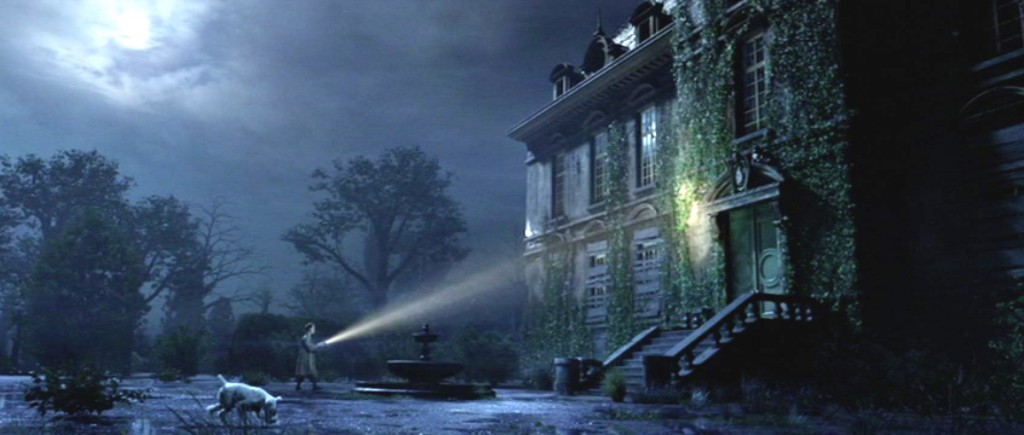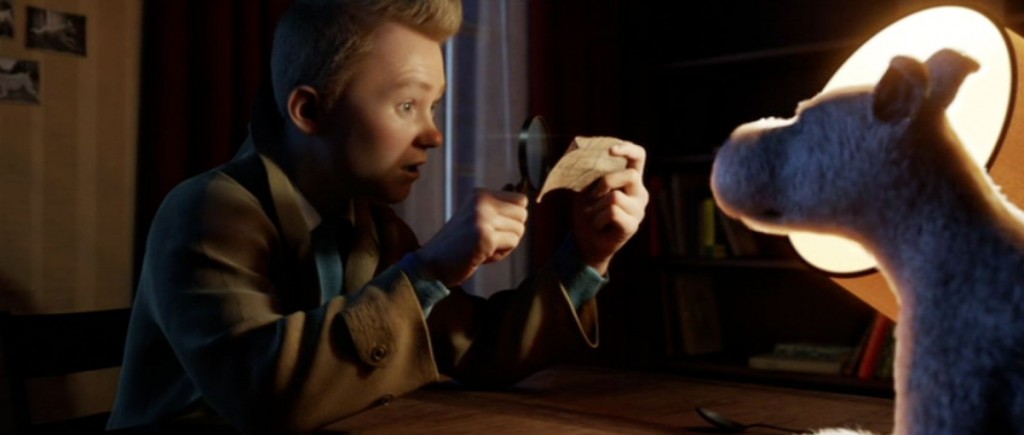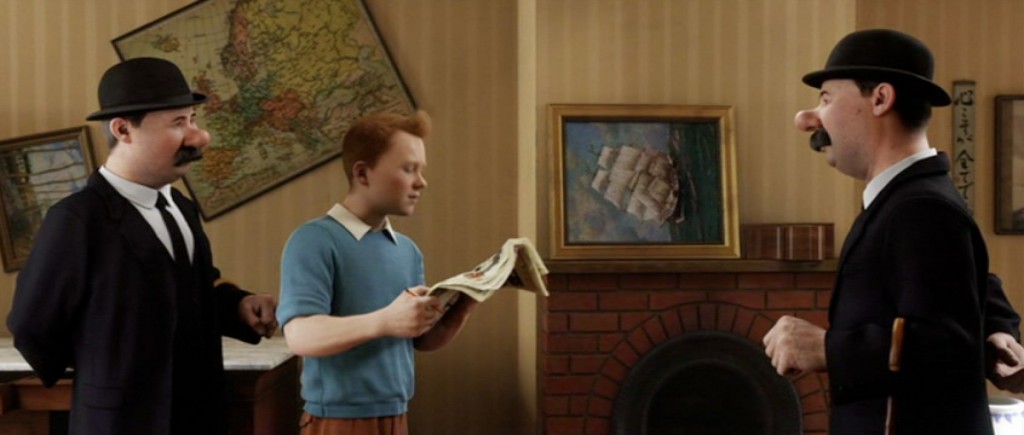Spielberg: The Adventures of Tintin part 3
Tintin comes home from the library, the temple where stories go, like magic idols, to lie dormant until someone can open their secrets again, to find that someone has stolen his model ship. To you or me, that might be the end of it — “Well, it was probably that creepy Sakharine guy,” we’d say, “Jesus, it’s a good thing I wasn’t here, he must be pretty desperate.” But Tintin, as we’ve seen, lives for adventure, even if it’s a boy’s-adventure sort of adventure. That is to say, this kind of adventure, we all know, comes only from certain kinds of books, a literary genre, The Hardy Boys for instance. The character of Tintin is a callback to the past, not a real past but an imaginary past. There was never a time when there really were 15-year-old boys trotting the globe, solving mysteries and writing about their adventures. Sherlock Holmes was based on a real guy, James Bond sprung from a specific geo-political climate, Indiana Jones battles people in a more-or-less historical context, but Tintin is pure fantasy, has always been pure fantasy, and was created as part of a continuum of pure fantasy. Which is another way of saying that Tintin isn’t about a guy, there is no “there” there in Tintin, his vagueness lets the viewer fill him in, Tintin is about stories, and what they mean to us, certainly what they mean to Spielberg. Tintin seeks adventure stories to will his life into being, just as Spielberg did. Tintin has his Unicorn, Spielberg had his shark and his aliens and his Holy Grail.
But I digress. Tintin, his model ship stolen, heads to Marlinspike Hall, a creepy old manse out in the country.
He encounters some bother as he sneaks in: a locked gate, a slightly-troublesome Rottweiler and a butler with a kosh. Snowy helps with the Rottweiler; he is, in many ways, Tintin’s avatar, brave and innocent and eager, and those qualities generally serve to get him into and out of trouble. Tintin’s bete noir, Sakranine, his double and his opposite, lives in the crumbling Marlinspike Hall and owns, to Tintin’s surprise, a second model of the Unicorn. There is mention of the doomed Haddock clan and Sakharine generally acting threatening.
The mystery laid out in Tintin is clever but spare. There are no dead ends or wasted parts, no cul-de-sacs or red herrings. It’s meant for children to follow, and exists only to pulls Tintin through the story. As I say, the movie isn’t about Tintin, exactly, it’s about Sakharine, and, we will find, his relationship with Marlinspike Hall and this cursed Haddock clan. Tintin will draw them together and allow them to settle their hash, but has no real stake in the outcome. It is, perhaps, the curse of the boy’s-adventure hero to always be the facilitator of other people’s stories. They have adventures, but cannot change, while others’ lives are turned upside-down by their actions.
Tintin comes home to his find, for the second time in a night, his apartment burgled. Snowy, in some ways the better detective, points out what the thieves (this is either a different set of thieves from the people who stole the Unicorn, or else the same set of thieves coming back for something) came for: the metal cylinder hidden in the model ship’s mast. The cylinder contains a scrap of paper with opaque verse inscribed on it. A clue! This kind of device, of course, refers back to pirate romances, popularized by Robert Louis Stevenson but dating back to the 1700s. Pirate maps and buried treasure are a literary device unto themselves, there has never been such a thing in real life. Like Jim Hawkins in Treasure Island, Tintin gets swept up into his own kind of romance — not with Sakharine or the looming Haddock, but with the central mystery of the Unicorn. That’s why Tintin doesn’t need or seek a girlfriend, his narrative is about falling in love with a story.
The mystery deepens as the American who has been following Tintin shows up at his door, warns him for a second time, and is promptly shot. (Tintin, like any fifteen-year-old living on his own, has his own gun, of course. Teenagers in adventure fiction used to always have their own guns and cars. The Hardy Boys were handy with guns, and so was Nancy Drew, that is, up until the 1950s, when the stories were all re-written to appeal to postwar sensibilities.) The dying man, in the tradition of dying men in adventure stories, leaves a clue in his own blood.
Now that there’s been a murder, Tintin must bring in the police, here represented by the bumbling Thomson and Thompson. Thomson and Thompson are, of course, also types, the clueless authorities (one of them actually introduces them as being “completely clueless”). Again, they are throwbacks, not to an actual past but to a literary past, to Lestrad perhaps. The Tintin stories have always juggled types, slotting them in comfortably next to one another, allowing the reader to enjoy the style without worrying about motivations, which makes Tintin a kind of busman’s holiday for Spielberg, a chance to take well-worn characters and put them into an exercise of style.
Thomson and Thompson are vaguely curious about Dawes, the murdered American (he was an Interpol agent), but they’re preoccupied with the pickpocket we saw lifting wallets in the market square at the top of the movie. The pickpocket is soon upon them and yoinks Tintin’s wallet, which contains the precious scrap of paper from the Unicorn. Tintin gives chase, but loses the pickpocket. Upset that he has lost his new love (that is, his new story), he returns home, unaware that his love has come looking for him in the form of some roughnecks, who push him into a crate and make off with him. Love has found Tintin, but part of love is, lest we forget, to be stolen away.




I don’t think the boy’s adventure curse is never to change–that’s the Peter Pan benefit of it all: we can go adventuring forever and not deal with anything that would shake us up.
(On the flip side, a Freudian would have a field day with this–Unicorn, mast, Marlinspike, a parade of erections with no women in sight. I’m not arguing for a latent homoeroticism in Tintin, more like a teenager’s discovery of his changing body.)
As more argument for the specifically textual nature of Tintin adventures, I’d want to look at those names, like Sakharine (who isn’t at all sweet), and Thompson and Thomson, which are harder to get across in a film, but easy to see in print..
Funny, my wife just made the same comparison to Peter Pan. That’s what drew her to Tintin as a child, the fact that he never changed, that he moved through the world and nothing stuck to him.
As for Freud, not just the Unicorn and the Marlinspike, but the Haddock as well. Haddock’s forebear lost his Unicorn, Haddock has lost his Marlinspike. Like a fish without a bicycle, as the t-shirt says.
The writers try to get around audiences missing the pun in “Sakharine” by having another character refer to him as “the sour-faced chap with the sugary name,” or having him go by the wonderfully silly alias “M. Sugare Additif” later on in the film.
Also, it wasn’t until my second viewing that I caught the delightful homage to “Hot Fuzz” that co-writer Edgar Wright sneaks into Thompson and Thomson’s introductory scene. One of them — I think the one portrayed by Simon Pegg — cheerfully notes that police work isn’t all about glamour and gunplay, but also involves a lot of paperwork.